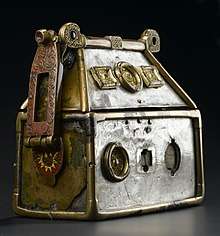Monymusk Reliquary
The Monymusk Reliquary is an eighth century Scottish reliquary made of wood and metal characterised by an Insular fusion of Gaelic and Pictish design and Anglo-Saxon metalworking, probably by Ionan monks. It is now in the National Museum of Scotland in Edinburgh.


It is an early example of the chasse or house-shaped reliquary, that became popular across Europe later in the Middle Ages, perhaps influenced by Insular styles. The Monymusk Reliquary is now empty. Its dimensions are W 112mm x D 51mm x H 89mm.[2]
It has been said to be the Brecbennoch of St. Columba (modern Gaelic Breac Bannoch or "embossed peaked-thing"), a sacred battle ensign of the Scottish army, used for saintly assistance, but is now thought not to be the object mentioned in historical records. Very few Insular reliquaries survive, although many are mentioned in contemporary records.
Style
It is characterised by a mixture of Pictish artistic designs and Irish artistic traditions (perhaps first brought to Scotland by Irish missionaries in the sixth century), fused with Anglo-Saxon metalworking techniques, an artistic movement now classified as Insular or Hiberno-Saxon art. The casket is wooden, but is covered with silver and copper-alloy. It was made around 750, probably by Ionan monks. It shows a combination of the Pictish and Insular styles which appear in manuscripts such as the Lindisfarne Gospels (c. 715 AD). The silver plates on the front and lid of the casket are decorated with beasts leaping and twisting, and biting at their tails on a spotted field, characteristic of animal style in Celtic art. The stippled punch marks are characteristically Irish in style.
The Brecbennoch
The Monymusk Reliquary was said to have contained relics of St. Columba, the most popular saint in mediaeval Scotland, and from the 19th century was believed to be the "Brecbennoch of St. Columba", a sacred battle ensign of the Scottish army, though this is now doubted by scholars.[3] The Brecbennoch may have been handed to the abbot of Arbroath Abbey during the reign of William I (r. 1165 - 1214), who in turn passed it to someone else's care at Forglen. The custodian was charged with the care of the reliquary, so that it could be used for saintly assistance by the Scots in battle. It was carried by the Scottish army who were victorious against the army of King Edward II of England at the Battle of Bannockburn (1314).
History
The Monymusk Reliquary was perhaps at Forglen until the sixteenth century, when both Forglen and Monymusk came into the hands of the Forbes family. In 1712 it was transferred to Sir Francis Grant of Cullen. It stayed in the Grant collection until 1933, when it was due to be auctioned, but was acquired by the National Museum of Scotland first, with the help of the Art Fund. It is arguably one of the most important pieces in the museum's collection.[4]
 The casket and lid are each carved from a solid piece of wood, and covered in thin bronze and silver plates. [5]
The casket and lid are each carved from a solid piece of wood, and covered in thin bronze and silver plates. [5] Side view
Side view From the vstyle of its ornament, the reliquary is thought to have been made towards the beginning of the 8th century.[6]
From the vstyle of its ornament, the reliquary is thought to have been made towards the beginning of the 8th century.[6] The silver plates are decorated with very faint interlacing animals and with bronze mounts featuring red enamel. [7]
The silver plates are decorated with very faint interlacing animals and with bronze mounts featuring red enamel. [7]
References
| Wikimedia Commons has media related to Monymusk Reliquary. |
- History, Scottish; read, Archaeology 5 min. "Monymusk reliquary". National Museums Scotland. Retrieved 2019-10-15.
- The Monymusk Reliquary Archived 2014-07-14 at the Wayback Machine at the National Museum of Scotland
- The Monymusk Reliquary Archived 2014-07-14 at the Wayback Machine at the National Museum of Scotland
- History, Scottish; read, Archaeology 5 min. "Monymusk reliquary". National Museums Scotland. Retrieved 2019-10-15.
- History, Scottish; read, Archaeology 5 min. "Monymusk reliquary". National Museums Scotland. Retrieved 2019-10-15.
- History, Scottish; read, Archaeology 5 min. "Monymusk reliquary". National Museums Scotland. Retrieved 2019-10-15.
- History, Scottish; read, Archaeology 5 min. "Monymusk reliquary". National Museums Scotland. Retrieved 2019-10-15.
Bibliography
- Wormald, Jenny (ed.), Scotland: A History, (Oxford, 2005), Plate 2, opp. p. 42
Further reading
- Caldwell, David H. (2001), "The Monymusk Reliquary: the Breccbennach of St Columba?", Proceedings of the Society of Antiquaries of Scotland, 131, archived from the original (PDF) on 17 January 2014
- Eeles, Francis C. (1933), "The Monymusk Reliquary" (PDF), Proceedings of the Society of Antiquaries of Scotland, 68, archived (PDF) from the original on 4 March 2016
External links
- The Monymusk Reliquary at the National Museum of Scotland
- Friends of Grampian Stones (archive link)